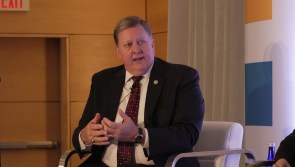FedScoop’s “#socialgov” feature highlights the people behind the federal government’s social media engagement.

Who
Scott Horvath
Web and Social Media Coordinator
U.S. Geological Survey, Department of the Interior
What are the ways your agency leverages social media?
At USGS, we have a number of social media services that we use. Each service has a specific purpose and so we try our best to take advantage of those unique capabilities of each service to further our mission. For all of the services, we see them as key ways to share information and educate people about the science that we’re involved with. However, we put a lot of time and energy into leveraging some of the services for improving our customer service relationships. With Twitter, for example, our customer service staff have fully integrated our @USGS account into their daily jobs. Whether it’s a tweet about an issue with a website, an earthquake or flood, or just a big thank you, our customer service staff is there waiting to respond.
We also use social media to help improve our own science knowledge. In the case of the Twitter, we have a project called @USGSted (Tweet Earthquake Dispatch) which picks up on earthquake-related tweets in multiple languages which, in turn, kicks off notifications to our scientists giving them a potential heads up that an earthquake event is occurring. Sometimes these notifications arrive after our seismic instrumentation has notified us already, and other times they arrive prior to the instrumentation. In both cases, the data from USGS TED can help to augment our overall understanding of the effects of an earthquake.
How does it tie into your agency’s mission?
Our overall goal is to provide unbiased science to the public, land managers, partners and cooperators, Congress, and others to help in making critical decisions about the planet we live on. Clearly “telling” people about the science we perform and the results we find is a natural fit for sharing through social tools. But with that sharing comes questions about that science. This is where social tools really shine in allowing those groups to directly connect with us, ask questions and, hopefully, get the answers they’re seeking.
What government social media advice do you have for others?
It’s easy to think about all the bad things that “could” happen if you did certain things in social media. When you do that for one thing, it tends to waterfall into other ideas. Then you end up preventing yourself from doing anything because you’re worried about what might happen. Certainly things can, and will, go wrong. But the question shouldn’t be “what will happen if … ” but rather, “what should I do when if happens?” That’s called planning. Bring it up a few notches and that’s called strategy.
It’s easy to start a Pinterest account, or join a new service that just launched, but why? Don’t do it just because you want to be the first. Don’t do it unless you have a clear strategy for why that tool is something you should be investing your time and energy into. Once you commit to using a certain tool, then work out possible scenarios for what you should do if something, like “x”, happens. Maybe “x” will never happen at all! But if it does, you’ll at least know how to respond. Don’t focus on just the crisis communications issues either … also plan for the good response from people. Know how to thank them or maybe consider something similar to a customer loyalty program. You may not be in the business of selling things, but you can certainly find creative ways to thank people for their appreciation.
What’s your personal benchmark for agency social media success?
Quality over quantity. Done. If a Twitter account has 100,000 followers, what does that really matter if only 1% of them are responsive and engaging? Sure, there is some level of benefit in being “popular” on Twitter and having lots of followers. At the same time, however, you really want responsiveness from people, then you want to turn that short-term engagement into long-term engagement. In the end, if we have an account with 500 followers, but a significant portion of those followers are actually engaging, asking questions, and retweeting, in my view that’s much better in terms of success.
What’s your personal favorite social media platform and why?
From a purely personal opinion, I prefer two: Twitter and Google+. For me, they really have two different uses. Twitter is great for that quick, engaging, responsive feedback. It’s great for keeping up with the latest things happening “at the moment.” But the nature of the medium doesn’t really allow for long form content and, to some extent, ease of viewing and filtering different types of shared content. That’s where, for me, Google+ comes in. Long form content is easily digestible, searchable and filtered through Google+. I also use Google+ for my personal photography work and I find the emphasis on multimedia much easier for me from a consumption standpoint.
A little bit of advice as well, even with your personal social media use, is that you need to have strategy for what you’re using. At one point, I found myself using over 10 different social media services at once. It was overwhelming and time consuming. I had to take a step back and ask myself, “What am I really trying to do? Is this tool doing that for me now or will it ever?” Once I asked myself that question, I dropped half of the services I was using. Since then, I’ve scaled back even more as I see the level of responsiveness from each channel. So, not only should your professional/agency use of social media use be based on a strategy, so should your personal use. Don’t do it just because you can. That’s not putting quality over quantity.






